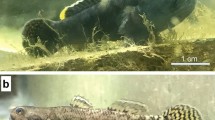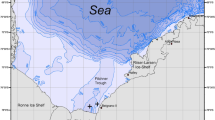Summary
The available information on the life-history ofHilsa ilisha (Ham.) is given briefly and discussed. The collections of eggs and early larvæ from the Hooghly River in West Bengal and from the Daya River (Orissa) are recorded. The spawning habits are given. The unfertilized egg which is 0·70 to 0·75 mm. in diameter, is almost spherical, transparent and demersal though it contains many oil-globules. A fair-sized femaleHilsa is estimated to contain 1 million eggs. Spawning seems to take place generally towards the evening. Stages of embryonic development up to the time of hatching are figured and described. At a water temperature of about 23° to 25° C, the egg hatches in about a day. The eggs hatch out just as well in 1% normal salt solution and in ordinary chlorinated tap water as in the river water. The newly hatched larva is 2·3 mm. long. The larvæ lived under laboratory conditions for a maximum period of 5 days attaining a length of 5·6 mm. Yolk is completely absorbed when it is about 8 mm. long. The larval development of the fish till it becomes a juvenile is described and figured. From available records it appears that growth during the first year is roughly at the rate of an inch per month. Our observations show that the fish descend into the sea during the first year of their life. The need for further study on the bionomics of the fish is indicated. The great damage done to theHilsa fishery by the capture of the countless fry and fringerlings of the fish in the tidal areas is stressed and the urgent need for the protection of the fry and the early stages is emphasized. The desirability for a proper survey of the spawning grounds in the rivers and further investigations into the fate of the egg and the larvæ that drift down the estuary is indicated.
Similar content being viewed by others
Abbreviations
- a.b.:
-
Air bladder
- a.c.:
-
Alimentary canal
- a.f.:
-
Anal fin
- a.o.:
-
Auditory organ
- bl.c.:
-
Blasto; dermal cap of cells
- ch.:
-
Chromatophore
- cf.:
-
Caudal fin
- d.f.:
-
Dorsal fin
- d.f.f.:
-
Dorsal fin-fold
- d.f.r.:
-
Dorsal fin rudiment
- e.:
-
Eye
- e.m.:
-
Egg membrane
- e.r.:
-
Embryonic ridge
- f.r.:
-
Fin radial
- g.r.:
-
Germ ring
- g.r.:
-
Growth ring
- h.:
-
Heart
- h.e.:
-
Head end of embryo
- i.g.r.:
-
Incomplete growth ring
- i.l.:
-
Inner layer of egg membrane
- l.:
-
Liver
- l.b.c.:
-
Lateral band of chromatophores
- l.e.p.:
-
Limit of exposed portion of scale
- my.:
-
Myotome
- mx.:
-
Maxilla
- nc.:
-
Notochord
- o.g.:
-
Oil-globule
- o.l.:
-
Outer layer of egg membrane
- o.a.:
-
Olfactory organ
- p.:
-
Protoplasm
- p.a.f.:
-
Pre-anal fin-fold
- p.f.:
-
Pectoral fin
- p.f.r.:
-
Pectoral fin rudiment
- ra.:
-
Radius
- sc.:
-
Scute
- st.:
-
Streaks on the surface of egg membrane
- t.e.:
-
Tail end of embryo
- v.f.:
-
Ventral fin
- v.:
-
Vent
- y.:
-
Yolk
- y.p.:
-
Yolk plug
- y.s.:
-
Yolk segment
References to Literature
Chacko, P. I., Zobairi, A. R. K. and Krishnamurthi, B. “The Radii of Scales ofHilsa ilisha (Hamilton) as an index of Growth and Age,”Curr. Sci., 1948,17, 158–59.
Chacko P. I. and Ganapati, S. V. “On the Bionomics ofHilsa ilisha (Hamilton) in the Godavari River,”Journ. Madras Univ., 1949,18, 16–22.
Day, F.Report on the Freshwater Fish and Fisheries of India and Burma, 1873a, pp. 22, 23, 35 and 36.
-Report on the Sea Fish and Fisheries of India and Burma, 1873b, pp. 24, 25 and App. pp. i, xxxi, cxxi, cxxii.
-Fishes of India, 1878, pp. 638, 640.
Devanesan, D. W. “Research Work on theHilsa,”Curr. Sci., 1942,8, 126.
— “Weirs in South India and their effect on the Bionomics of theHilsa in the South Indian Rivers—The Godavari, the Kistna and the Cauvery,” —Ibid., 1942,11, (10), 398.
Hamilton, F.An Account of the Fishes found in the River Ganges and its branches, Edinburgh, 1822, 243–46.
Hora, S. L. “A preliminary Note on the Spawning grounds and Bionomics of the so-called Indian ShadHilsa ilisha (Hamilton) in the River Ganges,”Rec. Indian Mus., 1938,40, 147–58.
— “Life History and Wanderings ofHilsa in Bengal Waters,”Journ. Roy. Asiat. Soc. Bengal, Science, 1940,6 (2), 93–112 (1941).
— and Nair, K. K. “Further Observations on the Bionomics and Fishery of the Indian Shad,Hilsa ilisha (Hamilton), in Bengal Waters,”Rec. Indian Mus., 1940a,42, 35–50.
— “The Jatka fish of Eastern Bengal and its significance in the Fishery of the so-called Indian Shad,Hilsa ilisha (Hamilton),” —Ibid., 1940b,42, (4) 553–65.
Jenkins, J. T. “Spawning ofHilsa,”Curr. Sci., 1938,7, 251–252.
Job, T. J. “Hilsa Investigations in Bengal Waters,”Sci. and Cult., 1942,7, 427–29.
Johnson, Fred R. “Marketing of Shad on the Atlantic Coast,”Investigational Rept., 1938, No. 38,2,U.S. Dept. Comm., Washington.
Jones, S. “Observations on the Breeding Habits and Development of certain Brackishwater Fishes of Adyar, Madras,”Proc. Ind. Acad. Sci., 1937,5 (6), 261–89.
— and Menon, P. M. G. “Spawning Habits and Development of the Gangetic Anchovy,Setipinna phasa (Hamilton),”Curr. Sci., 1950a,19, 25.
— “Spawning ofHilsa ilisha (Hamilton) in the Hooghly River,”Sci. and Cult., 1950b,15 (11), 443–44.
Leach, G. C. “Artificial Propagation of Shad,”U.S. Bur. Fish. Doc., 1925, No. 981, 459–86.
Mazumdar, C. H. “Foreshore Fishing in the Eastern Part of the Bay of Bengal,”Sci. and Cult., 1939,5, 219.
Nair, K. K. “On Some early stages in the Development of the so-called Indian Shad,Hilsa ilisha (Hamilton),”Rec. Indian. Mus., 1939,41, 409–18.
Prashad, B.Annual Report of the Dept. Fish. Bengal, Bihar and Orissa for the year ending 31stMarch, 1919, p. 4.
Prashad, B., Hora, S. L. and Nair, K. K. “Observations on the Seaward migration of the so-called Indian Shad,Hilsa ilisha (Hamilton),”Rec. Ind. Mus., 1940,42, 529–52.
Raj, B. Sundara “On the habits of theHilsa (Clupea ilisha) and their artificial propagation in the Coleroon,”Journ. Proc. Asiat. Soc., Bengal (N. S.), 1917,13, p. clxxxiv.
-Madras Fisheries Department Administration Report for the year 1930–31, 1932, p. 32.
-Ibid., 1935–36, 1937, p. 38,
Raj, B. Sundara “Dams and Fisheries; Mettur and Its Lessons for India,”Proc. Ind. Acad. Sci., 1941,14 (4), 341–58.
Southwell, T. “Report onHilsa-hatching operations conducted at Monghyr, Bihar, during August, September and October, 1912,”Bull. Dept. Fish. Bengal, Bihar and Orissa, 1914, No. 4, 1–5.
— and Prashad, B. “OnHilsa Investigations in Bengal, Bihar and Orissa,” —Ibid., 1918, No. 11, 6–12.
Wilson, H.C. “Artificial propagation ofHilsa in the Coleroon,”Govt. of Madras, Revenue Dept., G.O., 1219, 1909 (5th May).
Author information
Authors and Affiliations
Additional information
Communicated by Prof. L. Rama Rau
Published with the permission of the Chief Research Officer, Central Inland Fisheries Research Station, Barrackpore.
Rights and permissions
About this article
Cite this article
Jones, S., Menon, P.M.G. Observations on the life-history of the Indian shad,Hilsa ilisha (Hamilton). Proc. Indian Acad. Sci. 33, 101–124 (1951). https://doi.org/10.1007/BF03049975
Received:
Issue Date:
DOI: https://doi.org/10.1007/BF03049975




